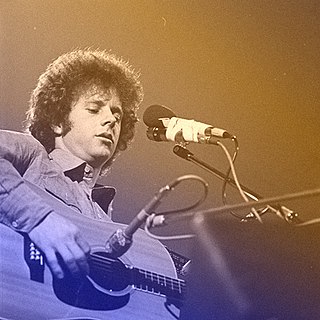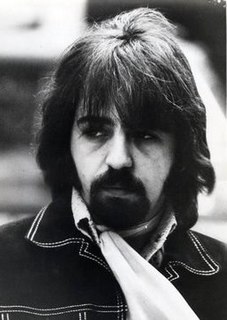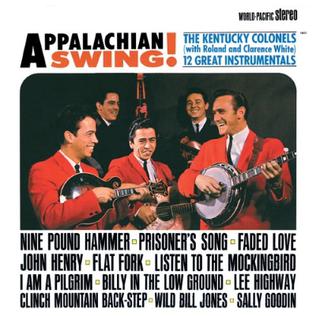
William Smith Monroe was an American mandolinist, singer, and songwriter, who created the bluegrass music genre. Because of this, he is often called the "Father of Bluegrass".

Bluegrass music is a genre of American roots music that developed in the 1940s in the United States Appalachian region. The genre derives its name from the band Bill Monroe and the Blue Grass Boys. Unlike mainstream country music, bluegrass is traditionally played on acoustic stringed instruments. Bluegrass has roots in traditional English, Scottish, and Irish ballads and dance tunes and in traditional African-American blues and jazz. Bluegrass was further developed by musicians who played with Monroe, including 5-string banjo player Earl Scruggs and guitarist Lester Flatt. Monroe characterized the genre as: "Scottish bagpipes and ole-time fiddlin'. It's a part of Methodist, Holiness and Baptist traditions. It's blues and jazz, and it has a high lonesome sound."

Old-time music is a genre of North American folk music. It developed along with various North American folk dances, such as square dancing, clogging, and buck dancing. It is played on acoustic instruments, generally centering on a combination of fiddle and plucked string instruments, most often the banjo, guitar, and mandolin.

Christopher Hillman is an American musician. He was the original bassist and one of the original members of The Byrds, which in 1965 included Roger McGuinn, Gene Clark, David Crosby and Michael Clarke. With frequent collaborator Gram Parsons, Hillman was a key figure in the development of country rock, defining the genre through his work with The Byrds, The Flying Burrito Brothers, Manassas and the country-rock group The Desert Rose Band.

Muleskinner was an American bluegrass supergroup, active during the early 1970s.

Clarence White was an American bluegrass and country guitarist and singer. He is best known as a member of the bluegrass ensemble the Kentucky Colonels and the rock band the Byrds, as well as for being a pioneer of the musical genre of country rock during the late 1960s.

Appalachian music is the music of the region of Appalachia in the Eastern United States. Traditional Appalachian music is derived from various influences, including the ballads, hymns and fiddle music of the British Isles, the African music and blues of early African Americans, and to a lesser extent the music of Continental Europe.
Larry Sparks is an American Bluegrass singer and guitarist. He was the winner of the 2004 and 2005 International Bluegrass Music Association Male Vocalist of the Year Award. 2005, won IBMA for Album of the Year and Recorded Event of the Year for his album "40," celebrating his 40th year(2003) in bluegrass music.
Eric Weissberg was an American singer, banjo player, and multi-instrumentalist, whose most commercially successful recording was his banjo solo in "Dueling Banjos," featured as the theme of the film Deliverance (1972) and released as a single that reached number 2 in the United States and Canada in 1973.
Gene Victor Parsons is an American drummer, banjo player, guitarist, singer-songwriter, and engineer, best known for his work with the Byrds from 1968 to 1972. Parsons has also released solo albums and played in bands including Nashville West, the Flying Burrito Brothers, and Parsons Green. Along with guitarist Clarence White, he is credited with inventing the B-Bender —a device which allows a guitarist to emulate the sound of a pedal steel guitar. The device is often referred to as the Parsons/White B-Bender, a trademarked name.

Doyle Lawson is an American traditional bluegrass and Southern gospel musician. He is best known as a mandolin player, vocalist, producer, and leader of the 6-man group Doyle Lawson & Quicksilver. Lawson was inducted into the International Bluegrass Music Hall of Fame in 2012.
The Johnson City Sessions were a series of influential recording auditions conducted in Johnson City, Tennessee, in 1928 and 1929 by Frank Buckley Walker, head of the Columbia Records "hillbilly" recordings division. Certain releases from the Johnson City Sessions—especially Clarence Ashley's "The Coo-coo Bird" and The Bentley Boys' "Down On Penny's Farm"—are considered by music scholars as important recordings of early country music that influenced a whole generation of revivalist folk musicians of the 1950s and 1960s, including Bob Dylan, Joan Baez, and Doc Watson.

Roland White was an American bluegrass music artist, performing principally on the mandolin.

William Bradford "Bill" Keith was a five-string banjoist who made a significant contribution to the stylistic development of the instrument. In the 1960s he introduced a variation on the popular "Scruggs style" of banjo playing which would soon become known as melodic style, or "Keith style".

Alan Munde is an American five-string banjo player and bluegrass musician.
Sierra Records is an independent record label based in Etiwanda, California.
Roger Bush is an American bassist and guitarist.

Appalachian Swing! is the second album by the American bluegrass band the Kentucky Colonels and was released on April 20, 1964 on World Pacific Records. Although it failed to chart in America, the album sold reasonably well over the course of the year and became an influential underground classic. A number of critics and authors have commented on how guitarist Clarence White's flatpicking guitar style on the album influenced the development of bluegrass guitar playing.
Larry Prentis Rice was an American mandolinist, singer, songwriter, and band leader in the bluegrass tradition. He is known for his solo albums and for his unique syncopated mandolin picking style.
Herschel Sizemore is an American mandolinist in the bluegrass tradition.












